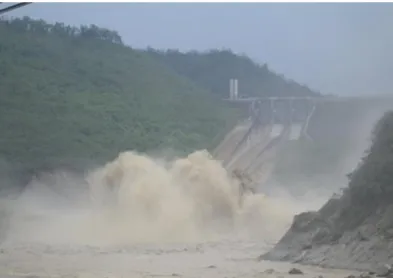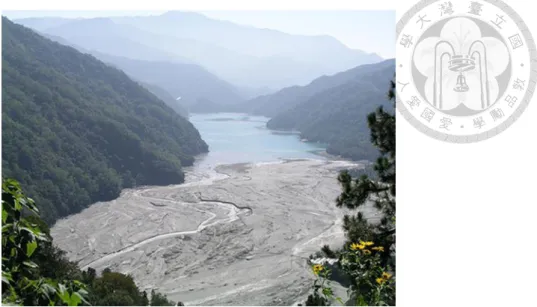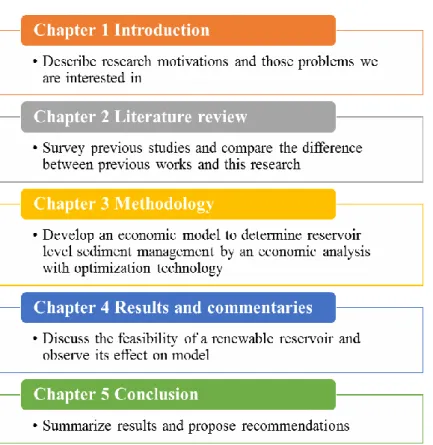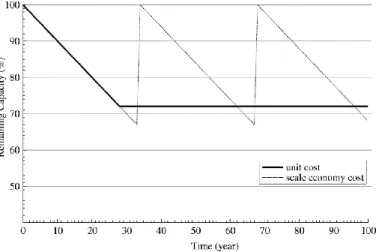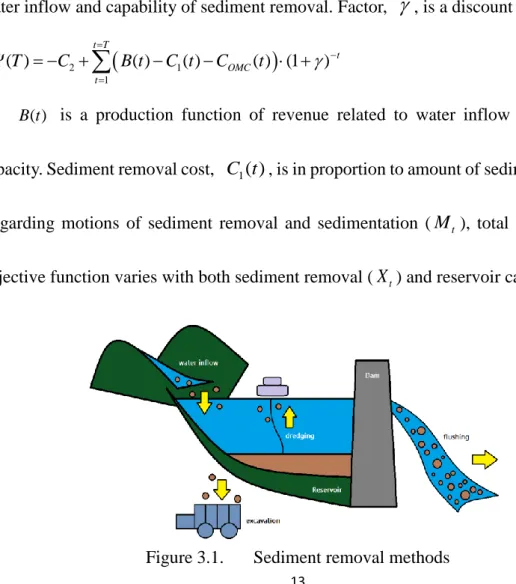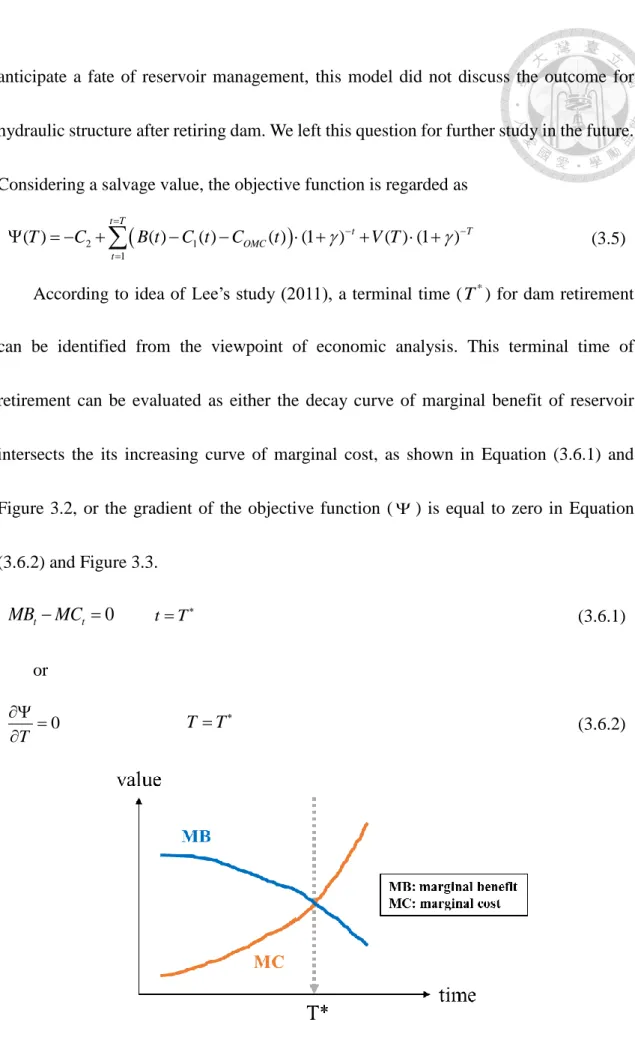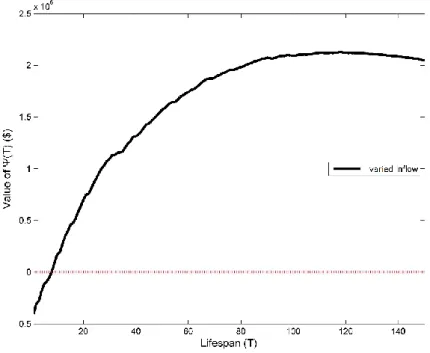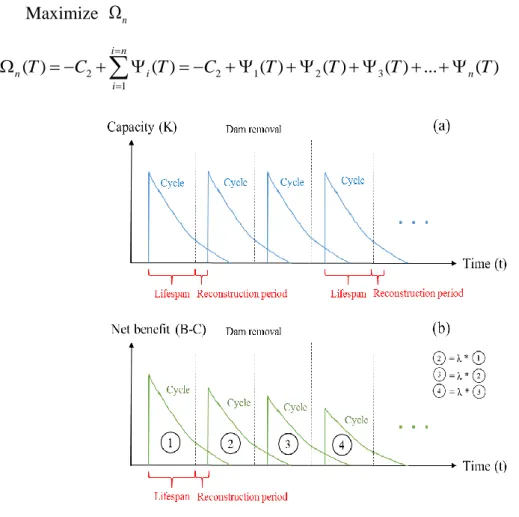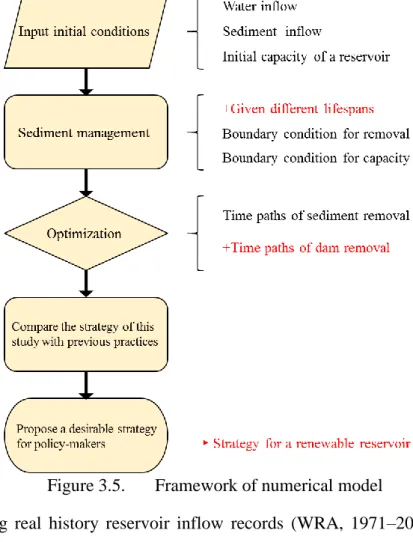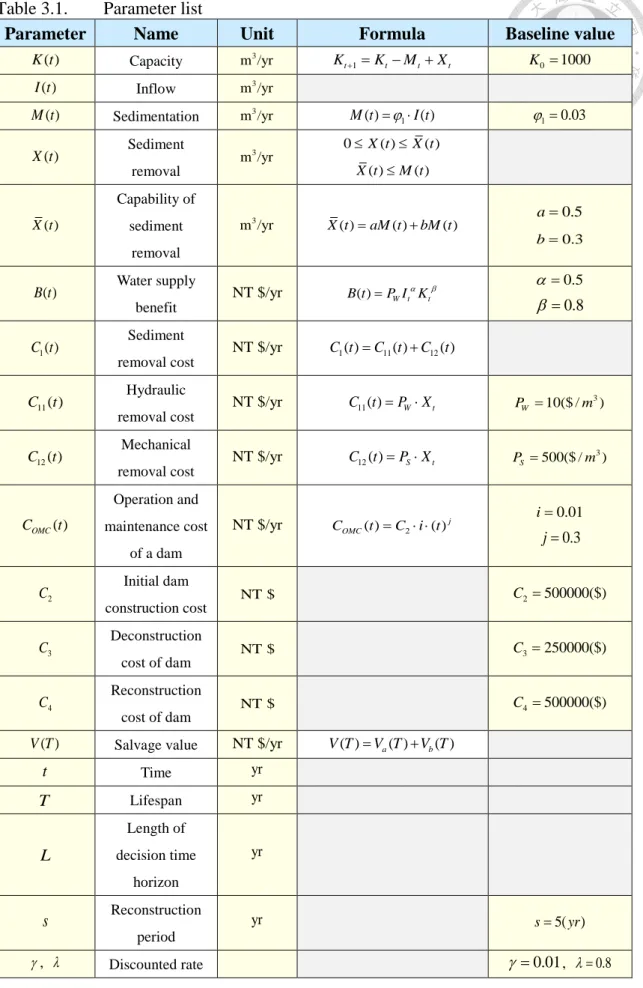國立臺灣大學土木工程學系 碩士論文
Department of Civil Engineering College of Engineering National Taiwan University
Master Thesis
水庫永續經營管理策略之研究
The Optimal Strategy of Sustainable Reservoir Management from a Long-term Perspective
林馥苡 Fu-Yi Lin
指導教授:游景雲 博士
Advisor: Gene Jiing-Yun You, Ph.D.
中華民國 104 年 7 月
July 2015
i
口試委員會審定書
ii
誌謝
回想當初懷抱著一顆期待的心進入新環境,卻沒想到碩士生活是如此地 不容易,寫不完的作業、找不完的程式 bug、熬不完的夜、釋放不完的壓力…
等,那些種種讓我像坐太空梭一般過完兩年的時光,雖然,做研究很辛苦卻 也很值得,一路上感謝許多人的陪伴與支持,因為有他們的幫助我才能如期 如願完成碩士學業。
謝謝我的指導教授游景雲老師。人們常說老闆的好壞決定部屬的未來,
很開心我在碩士生活中跟對了老闆,因著老師不厭其煩的細心指導及重視學 生的心,讓愚鈍的我也能在研究路途上找到一線曙光。
感謝 815 研究室的好夥伴及水利組好同學: 姊姊一樣的郁雯、心靈綠洲 的家駒、真不愧是 John 的玉娟、營造廠小開正倫、土研最有錢的周博、總是 幫很大的智傑學長、樂天的毓茹、學長姊、學弟妹…等,大家就像一個 family 彼此扶持,難過的時候相互傾訴、開心的時候一同享樂,像是用筆電 K 歌或 吃水煮餐閒聊的日子,我都好珍惜,另外特別感謝郁雯和家駒,同樣身為游 家班的一份子,許多事情都是共同承擔,雖然生論文很不容易但有你們的陪 伴讓我度過許多低潮也給予我往前衝的動力,感謝上帝讓我不僅很幸運地遇 到好的老師也擁有一群對的同學。
除了學校的師長和戰友們,家人的愛更成就了我今日的一切,感謝我的 媽媽、大哥、小哥、嫂嫂、小搗蛋阿 Q、偉綸的爸爸媽媽及在天國的父親,
你們所給予我的一百分支持使我能無掛慮的專注學業,沒有你們我絕對無法 完成夢想。最後,謝謝在我身邊最親密的你,偉綸,你曾說我是你努力的榜 樣,其實你才是我人生的標竿,雖然我外表看似堅強但實質內心軟弱,時常 需要你的依靠讓我充電再出發,還好你總能大肚地包容我的情緒,適時地替 我開導和給予幫助,一直以來謝謝你那麼地愛我。
iii
中文摘要
因降雨時空分布不均和可用水資源有限等問題,水庫建用以調蓄水資源,
滿足農業灌溉、工業用水、民生需求等目的,水庫壩體阻斷自然輸砂機制致 使大量泥砂沉積,淤砂不僅減少水庫蓄水空間,也縮短水庫營運壽命且危害 壩體安全,成為一大隱憂。面對此等難題,泥砂清淤為工程上經常使用的手 段,然而計畫性的清淤成效不如預期,淤砂速度始終快於清砂效能,嚴重的 淤砂會迫使許多水庫面臨退役的問題,影響水庫永續利用的規劃。在某個特 定時間,應當重新評斷壩體的續存問題,其中拆壩也是需考慮的選項之一,
以往研究多半關心拆壩後對環境所造成的影響,然而拆除壩體的同時,河川 可以在短期內得迅速移除庫內淤積泥砂,恢復自然條件。
在未來,若是水庫廢棄無法再生利用,旱季時造成供水不足,成為社會 的重要問題。若視水庫相當於一種社會資源,在技術可行下,資源再生也將 成為一種解決方式,本研究基於原壩址可以拆除後再重新興建的假設上,嘗 試將清淤規劃結合壩體的再生進行探討,透過最佳化工具和經濟分析,在長 期水庫效益最大化的前提下,基於資源理論的觀點,建構模式以模擬不同條 件下短期或長期的水庫操作,分析清淤時間點和清淤量之決策等,最終,評 估是否將水庫視為可更新資源或不可更新資源利用,相較於不可更新資源,
研究須探討庫容的再生對模式的影響。本研究期望努力的最後,能夠提供水 庫操作者具備永續性且有效的水庫淤砂處理的政策原則及方案擬定概念。
關鍵字:水庫清淤、可更新水庫之經營規劃、經濟分析
iv
ABSTRACT
Reservoir management faces a crucial challenge from watershed sedimentation, which can significantly influence the sustainability of reservoirs. To maximize value of reservoirs and extend its lifespan, strategies of more effective and sustainable reservoir operation are always desired. For this purpose, sediment removal schemes such as dredging and flushing are usually considered; otherwise, dam decommissioning is also widely discussed. The issues raised after dam decommissioning are should we rebuild it, remove it, or just deposit the dam as it is. In the previous studies, retrofitting dam and sediment removal issues are discussed separately in the aspect of reservoir benefit estimation. However, it is very likely that sediment management might be related to dam removal problem. Using an economic analysis and an optimization, this study established a model to explore the log-term reservoir management regarding sediment removal and dam removal, thereby identifying whether operate reservoirs as renewable resources or non-renewable resources at the end of reservoir’s life. As a renewable resource, lifespan of reservoir could be extended indefinitely in contrast to as a non-renewable resource. As a consequence, we expect a better strategy can be proposed for sustainable management of reservoirs.
Keywords: Sediment removal, reservoir renewal, economic analysis
I
CONTENTS
口試委員會審定書 ... i
誌謝 ... ii
中文摘要 ... iii
ABSTRACT ... iv
Introduction ... 1
1.1 Background ... 1
1.2 Research motivations ... 2
1.3 Framework of study ... 4
1.4 Outline of this work ... 5
Literature Review ... 6
The prevalence of reservoir sediment problems ... 6
Influence of sedimentation on reservoir ... 6
Managing sedimentation ... 6
Feasible sediment management strategies ... 7
2.2.1 Available sediment removal approaches ... 7
2.2.2 Management composition ... 8
2.2.3 Difference between this study and previous researches ... 8
A new perspective of reservoir sediment management ... 10
Methodology ... 12
3.1 Research purposes ... 12
3.2 Evaluating value of reservoir ... 12
3.2.1 An economic model ... 12
3.2.2 Reservoir sediment management regarding dam removal ... 17
3.2.3 The objective function in analytical form... 21
3.3 Model procedure ... 24
3.3.1 Benefit function ... 25
3.3.2 Cost functions ... 26
3.3.3 Salvage value ... 27
3.4 Analytical solution for identifying the optimal lifespan ... 28
3.5 Sensitivity analysis ... 31
Results and commentaries ... 34
4.1 Reservoir management without dam reconstruction ... 34
4.1.1 Inflow condition ... 34
4.1.2 Time paths of sediment removal ... 39
4.1.3 Sensitivity analysis of the function of Ψ(T) ... 41
4.2 Reservoir management with dam reconstruction ... 43
II
4.2.1 Reservoir management from a short-term perspective ... 44
4.2.2 Reservoir management from a long-term perspective ... 48
4.2.3 Time paths of sediment removal ... 51
4.2.4 The effect of decision time horizon on model ... 53
4.3 Comparing analytical solutions with numerical solutions ... 54
Conclusion ... 56
5.1 Summary ... 56
5.2 Limitations and recommendations... 57
REFERENCES...58
III
LIST OF FIGURES
Figure 1.1. Sediment releasing during Typhoon Morakot at Zengwun reservoir ... 3
Figure 1.2. Sediment accumulation in Wushe reservoir (徐嬋娟 攝) ... 4
Figure 1.3. Outline of this study ... 5
Figure 2.1. The time path of remaining capacity for dredging (Kawashima, 2007) ... 9
Figure 3.1. Sediment removal methods ... 13
Figure 3.2. Curve of marginal benefit intersects curve of marginal cost ... 15
Figure 3.3. The objective function with varied inflow without concept of the reservoir renewal... 16
Figure 3.4. (a) Time path of repeated capacity rehabilitation. ... (b) Time path of net benefit as 0 1... 20
Figure 3.5. Framework of numerical model ... 24
Figure 4.1. Results of the objective function with different inflow conditions ... 35
Figure 4.2. Average of the objective function with respect to lifespan ... 35
Figure 4.3. Comparing the original objective function without salvage value with the objective function regarding salvage value (partial enlarged drawing)... 37
Figure 4.4. Performance of the objective function with sediment removal in contrast to the objective function without sediment removal... 38
Figure 4.5. Marginal effect of sediment removal ... 40
Figure 4.6. Sensitivity analysis for capability of sediment removal (Uniform inflow) 42 Figure 4.7. Sensitivity analysis for time discount rate (Uniform flow) ... 43
Figure 4.8. Performances of the objective function with different social preference rates of (From a short-term perspective) ... 45
Figure 4.9. Comparing reservoir management strategy of this study with traditional practice... 45
Figure 4.10. Sensitivity analysis of discount rate of (L=150 yr) ... 46
Figure 4.11. Sensitivity analysis of dam construction cost (L=150 yr) ... 47
Figure 4.12. Performances of the objective function with different social preference rates of (From a long-term perspective) ... 49
Figure 4.13. Sensitivity analysis of discounted rate of (L=300 yr) ... 50
Figure 4.14. Sensitivity analysis of dam construction cost (L=300 yr) ... 51
Figure 4.15. Marginal effect of sum of sediment removal ... 52
Figure 4.16. The effect of decision time horizon on model ... 53
IV
LIST OF TABLES
Table 3.1. Parameter list ... 33 Table 4.1. List of sensitivity analysis of Ψ(T) ... 41 Table 4.2. Solutions of optimal lifespan ... 55
1
Introduction
1.1 Background
People build reservoirs to store water resources on the purpose of satisfying the needs of agricultural, municipal and industrial uses, hydropower and other aims. While rivers are intercepted by hydraulic structures built to store water, sediment are also trapped then cannot be transported to downstream by water flow. Watershed sedimentation would decrease the reservoir capacity, increase risk of dam safety, shorten the lifespan of reservoir and reduce social welfare. Recently, more and more reservoirs worldwide face the end of lifespan attributed to sediment accumulation mostly. This growing problem imposes crucial challenges on reservoir management and significantly influences the sustainability of reservoirs; therefore, sediment removal is under the consideration of sustainable sediment management. With the state of the art, sediment removal approaches include hydraulic (flushing, hydrosuction and sluicing) and mechanical (dredging and excavation) schemes.
Once a reservoir is completely filled by sediment, theoretically the economic life of project is ending. It is time to consider decommissioning of a dam by evaluating the benefit of operation and salvage value of the reservoir. After retiring the dam, it remains uncertain whether we should rebuild, remove it or even leave it alone. Moreover, due to the limitation of new sites of dam construction, especially land use like Taiwan, both
2
sediment removal and dam retirement issues should be carefully examined from a sustainable perspective before coming the end of reservoir’s life.
1.2 Research motivations
Engineers are concerned with how to determine an effective strategy of sediment management to maximize the reservoir benefit and prolong its life for storing water. In previous studies, dam retirement and sediment removal are discussed separately in the aspect of reservoir value estimation. It is very likely that sediment management might be related to dam removal issue. Regardless of consequences to downstream and nature, dam removal is an approach that assists people to remove sediment and saves maintenance cost of aged infrastructures. In addition, regarding extreme hydrologic events, it is worth questioning the myth that removing sediment continually to extend storage life may achieve the economic benefits as expected.
For example, in 2009, Typhoon Morakot struck southern Taiwan and caused severe damage. The sediment which came with extreme rainfall had reduced the capability of Zengwun reservoir (see Figure 1.1). Those sediment occupied more than fifteen percent of original storage capacity (Water Resources Agency in Taiwan, 2010). Consequently, it would spend lots of time and money to deal with such significant sludge. Another remarkable example is Baihe reservoir located at Tainan city in southern Taiwan.
Sediment inflow from watersheds and Typhoon Morakot almost occupied half of original
3
capacity, thereby influencing the function for agricultural water supply due to the loss of capacity (WRA, 2012). Merely depending on sediment removal mechanism to manage sedimentation seems not a desirable plan to correspond economic demand.
Besides, most available sediment removal methods are inefficient. Sediment accumulation problem keeps getting worse on reservoirs in service worldwide. For instance, Wushe reservoir in Taiwan, as shown in Figure 1.2, has worked fifty-five years for generating electric power since 1960. According to the latest records (WRA, 2012), the remaining usable capacity left only less than forty percent of original capacity. Despite these reservoirs (above cases) are expected to live as longer as possible, the actual problems often go beyond our control. As a result, this study attempted to investigate the combination of dam removal and other measures as one of strategies of sediment management. We tried to make capacity renewable but non-sustainable to increase benefit from reservoir management by rebuilding dams.
Figure 1.1. Sediment releasing during Typhoon Morakot at Zengwun reservoir
4
Figure 1.2. Sediment accumulation in Wushe reservoir (徐嬋娟 攝)
1.3 Framework of study
Several challenges of sediment management remain to be overcome such as how to avoid sediment accumulating, choose appropriate removal methods and decide the programs of capacity rehabilitation. This study treated reservoirs as renewable resources rather than exhausted one. So we particularly focused on time paths of sediment removal and benefit along with dam rebuilding. Using an economic analysis with optimization approach, this research developed a model to simulate a long-term reservoir management regarding sediment removal and dam removal, thereby identifying whether operate reservoirs as renewable resources or non-renewable resources at the end of lifespan. As a renewable resource, lifespan in a broad sense can be extended infinitely in contrast to a non-renewable resource. In brief, we expected that employing the concept of resources to address sedimentation may propose a better strategy for policy-makers, enable reservoir operation to attain more profit and be able to respond to future change.
5
1.4 Outline of this work
This study was discussed with five chapters including introduction, literature review, methodology, results and commentaries and conclusion. Figure 1.3 indicates outline of our work.
Figure 1.3. Outline of this study
6
Literature Review
The prevalence of reservoir sediment problems
Influence of sedimentation on reservoir
Facing insufficient water resources, people build reservoirs to store water but also trap sediment. Recently, more and more reservoirs face the difficulties in their operation as a consequence of serious sedimentation. The sediment trapped in reservoirs would decrease effective capacity, diminish the function and also shorten the lifespan of reservoir. Based on previous study, about 0.5-1.0% of global water storage is lost annually due to sedimentation (White, 2001). Sedimentation gradually diminishes the value of existing dams and imposes economic loss to our society. Although the process of sediment depositing is slow, the accumulated amount of loss capacity over time is significant (Kawashima, 2007). Without an effective strategy of reservoir sediment management, reservoirs would eventually need to be retired soon or later. In addition, the economic cost of replacing dams might be substantial (Palmieri et al., 2001), thereby preserving reservoir capacity becoming a high priority. Such problem can be considerably deferred if sedimentation is minimized.
Managing sedimentation
In the past, many studies paid effort on reservoir sediment management (George et al., 2014). This issue has been extensively discussed on watershed or reservoir level. Lee
7
et al. (2011) presented an optimal control model of integrated watershed management in the presence of a dam including upstream soil conservation, reservoir level sediment removal and downstream damage control. Watershed management can mitigate sediment impact to downstream structures but not enhance more capacity for water storage while sedimentation proceeds to occur (Kawashima, 2007). As a result, this study mainly discusses reservoir level sediment management from a long-term perspective.
Feasible sediment management strategies
2.2.1 Available sediment removal approaches
To prevent sediment problem deteriorating and prolong longevity of projects, sediment removal methods are needed. Hydraulic and mechanical removal methods such as sluicing, flashing, hydrosuction (Huffaker and Hotchkiss, 2006), dredging, excavation and other ways are usually considered. However, performance of these available methods do not achieve the goal as expected. For example, cost of hydraulic removal methods is lower than mechanical methods. It is mostly implemented during flood season, so without adequate precipitation there would be no surplus water for sediment releasing. On the other hand, mechanical removal methods are independent of weather, but it takes much more time to complete given tasks. Hence, it is very important to determine a feasible sediment removal program to effectively utilize these methods in order to enhance storage capacity economically.
8
2.2.2 Management composition
To answer the difficult question, the economic analysis may be an appropriate estimation approach. Using an economic analysis, sediment management could be clearly analyzed and quantified with respect to their values. It appears that dealing with siltation matters is similar to the concept of different water resource infrastructures such as pipes maintenance (Kleiner et al., 1998). A Reservoir could be recognized as the behalf of water distribution system and every loss capacity could be regarded as an old pipe. What engineers are mostly concerned is that programs a time path of replacing and chooses numbers of retired object. Dorfman (1969) extended the optimal control theory with an economic interpretation which helps operators or systems optimize their decision- makings by analytical way. Sediment removal program is one of beneficiaries.
2.2.3 Difference between this study and previous researches
Because the work of dam construction is costly, in general, engineers attempt to operate reservoir as long as possible. Hydraulic infrastructures used to be designed and operated for a time long enough. Based on reasonable assumptions, some researchers suggested that storage capacity can be conserved sustainably relying on their management strategies and effective sediment removal methods (Kawashima et al., 2003 and Kawashima, 2007). Aimed at environmental condition, these theories are subjected to:
9
X M (2.1)
where
X maximum capability of sediment removal (m /yr3 ) M annual trapped sediment (m /yr3 )
Under this constraint, sediment problem could be successfully controlled and not fill the capacity of reservoir. The core of these theses tends to discuss difference between time paths of management strategy before the end of lifespan. They used analytical or numerical methods to respond questions including when removal tasks should be implemented and how many sediment should be removed. Particularly, contribution from papers is able to identify whether annually sediment removal plans gain more profit in contrast to cyclical removal program. Based on their assumptions, these study indicated that storage capacity can be preserved at certain level to maximize total value of reservoir by decided time path (see Figure 2.1).
Figure 2.1. The time path of remaining capacity for dredging (Kawashima, 2007)
10
Despite it seems theoretically possible to extend lifespan of a reservoir infinitely, the fact of sedimentation has always exceeded our anticipation. According to the reality, this study is restricted to:
X M (2.2)
Once the storage capacity becomes empty, there may be no enough water resource to meet people’s demand under population growth. Later, the issue of dam decommissioning would be inevitably raised again. Clearly, the practicing that conserving capacity over a lasting but still finite period of time should be challenged. Many studies have addressed sediment management regarding salvage value and identified the optimal timing of dam retirement (Lee, 2011 and Palmieri, 2001), though, little is known about future treatment of a reservoir after dam decommissioning. It is not easy to make choices for policy-makers at the end of lifespan.
A new perspective of reservoir sediment management
Dam removal is one of the options among the measures of dam decommissioning.
Most people are interested in the influence of dam removal on environment. From other points of view, while dam is deconstructed, trapped sediment could be removed in large amount by water flow (Pizzuto, 2002, Shuman, 1995 and Simons and Simons, 1991). It is likely that the consequence of dam removal coincides with our expectation for solving sediment problems. In addition, the implication of the meaning of sustainability should
11
not be merely applied to extend a lifespan of an object. The meaning of sustainability probably imply that provides an opportunity to revive those are going to be silted up.
In the aspect of resource theory (Harris, J. M. (2006). Environmental and natural resource economics: A contemporary approach., Tietenberg, T., & Lewis, L. (2009).
Environmental & natural resource economics., and Ward, F. A. (2006). Environmental
and natural resource economics.), some resources can be considered as renewable but
some others may not. How about reservoirs? If reservoirs are non-renewable resources, they would be abandoned at the end of lifespan. On the other hand, storage capacity could be reproduced again and again by repeating dam reconstruction. There is no single lifespan but many short lifespans gather to become a long time path of sustainable lifespan.
This approach evaluates accumulated benefit over time instead of benefit from each cycle. Although the cost of dam reconstruction is considerable, it might be temporary loss for society but beneficial from a long-term perspective. If sedimentation continually
happens, our future will cover with the worry that profound sediment accumulation makes the end of reservoir’s life come more quickly than usual. In comparison with construction
cost and impact of water crisis, issue of dam rebuilding is much more acceptable.
Referring a resource theory to determine a sediment removal strategy may open a new sight.
12
Methodology
3.1 Research purposes
Reservoir sediment accumulation is an unflavored natural process and a problem to reservoirs we need to face. In previous studies, conserving capacity of reservoir has extensively been discussed for achieving sustainability. As a result, considering resource management, this study attempted to treat reservoirs as renewable resources for the sake of: (1) maximizing reservoir management benefit, (2) promoting the efficiency of sediment removal.
Using an optimization technique and an economic analysis, we established a numerical model to simulate the process of sedimentation at reservoir level, thereby optimizing sediment removal schemes. MATLAB was used for computation in this study.
By this way, we could propose a potential sustainable strategy of reservoir for future policy making.
3.2 Evaluating value of reservoir
3.2.1 An economic model
Analyzing sediment problems, this model applied an economic analysis to illustrate the practice of reservoir sediment management. Assumed that dam managers generate reservoir benefit to satisfy people’s demand through supplying water which is subjected to annual change of storage capacity. Benefit of generating electric power is not included
13
in this model. Capacity of reservoir is governed by sedimentation inflow and discharge which includes both hydraulic and mechanical sediment removal measures (see Figure 3.1). Initial cost of dam construction, annual benefit of reservoir operation, cost of sediment removal and operation and maintenance cost (OMC) of reservoirs are all considered. We defined the objective function (
) to accumulate annual net benefit of reservoir management until the end of lifespan as below. Initial construction cost (C2) could be excluded for a working reservoir. For consistency, each parameter in this modelis expressed in present value. Lifespan (
T
) , a period of reservoir’s life, is influenced by water inflow and capability of sediment removal. Factor,
, is a discount rate.
2 1
1
( ) ( ) ( ) ( ) (1 )
t T
t OMC
t
T C B t C t C t
(3.1)( )
B t is a production function of revenue related to water inflow and reservoir capacity. Sediment removal cost, C t1( ), is in proportion to amount of sediment removal.
Regarding motions of sediment removal and sedimentation (Mt), total benefit of the objective function varies with both sediment removal (Xt) and reservoir capacity (Kt).
Figure 3.1. Sediment removal methods
14
Maximize
( ) T
which is subjected to
1
t t t t
K K M X (3.2)
0, 0
Kt K , Xt
0,X (3.3)t t
X M (3.4)
This model optimized choices of arranging time paths of variables Xt and Kt to attain maximum reservoir benefit. Symbol t is a time step. K0 represents the initial capacity of reservoir, X is the maximum capability of sediment removal and t Mt represents annual sediment inflow which reduces capacity. According to reality, we assumed that sediment removal cannot be able to fully discharge sediment inflow;
therefore, sediment accumulation remains to happen at any moment. In addition, sediment removal in this study only manages annual incoming sediment to reservoir instead of impounded sediment in reservoir.
Attributed to the Equation (3.4), this is a finite optimal control problem that reservoir’s capacity could not be indefinitely maintained at certain level because sediment
income is in excess of removal. If a reservoir is required to be decommissioned, salvage value should be taken into consideration at time
T
. Salvage value could be positive or negative depending on whether the cost of dam reconstruction is set to be sufficiently high. It can be only estimated at the end of lifespan. In addition, although we could15
anticipate a fate of reservoir management, this model did not discuss the outcome for hydraulic structure after retiring dam. We left this question for further study in the future.
Considering a salvage value, the objective function is regarded as
2 1
1
( ) ( ) ( ) ( ) (1 ) ( ) (1 )
t T
t T
OMC t
T C B t C t C t V T
(3.5)According to idea of Lee’s study (2011), a terminal time (T ) for dam retirement * can be identified from the viewpoint of economic analysis. This terminal time of retirement can be evaluated as either the decay curve of marginal benefit of reservoir intersects the its increasing curve of marginal cost, as shown in Equation (3.6.1) and Figure 3.2, or the gradient of the objective function () is equal to zero in Equation (3.6.2) and Figure 3.3.
t t 0
MB MC tT (3.6.1)
or T 0
T T (3.6.2)
Figure 3.2. Curve of marginal benefit intersects curve of marginal cost
16
It seems that despite the value of the objective function keeps positive, the performance of reservoir begins to go down from the time T in Figure 3.3. Many * reasons can lead to this consequence such as increasing cost of annual dam maintenance or decreasing benefit due to continually losing effective reservoir capacity.
The theoretical terminal time might be shorter or equal to lifespan of reservoir (T*T) depending on trade-off between benefit and cost. It could not be known before dam constructing but calculated by computer simulation. Other considerations such as ecological remonstration and dam safety would also make the terminal time different from original expectation. However, these conditions are not included in the framework of this model. By the way, Time step of numerical model is in annual while every parameter is also estimated in the price as annual-average.
Figure 3.3. The objective function with varied inflow without concept of the reservoir renewal
17
3.2.2 Reservoir sediment management regarding dam removal
For policy-makers, they might abandon a dam or remove a dam for river rehabilitation or even rebuild a dam to restore reservoir capacity when dam is to be decommissioned. Considering these options, the objective function would be reformed slightly with some extra costs.
If a dam is removed, a deconstruction cost (C3) is added to the Equation (3.5).
2 1
1
3
( ) ( ) ( ) ( ) (1 ) ( ) (1 )
(1 )
t T
t T
OMC t
T
T C B t C t C t V T
C
(3.7)Dam removal is discussed regarding its substantial expense and aftereffects on different sectors; however, it is also able to remove those sediment which accumulate in reservoirs is not successfully released by other sediment removal measures. To solve the problem of severe siltation, it is likely that dam removal may advance the efficiency of sediment management. Focused on this advantage, reservoirs could be defined as renewable resources.
As a renewable reservoir, capacity renewal is repeated over time; therefore, the lifespan of reservoir might not last forever but the reservoir itself is renewable. Lifespan of every cycle spreads on a long time stream and connects with each other. Although dam construction cost is considerable, future worth along with revival of reservoir capacity should not be ignored.
18
Gathering net benefit of each cycle, this study defined the new objective function ( ) and analyzed its consequences, thereby comparing new strategy of reservoir sediment management with traditional practices. Particularly, lifespan here becomes a new controlled variable. It is highly relevant to times of dam reconstruction (n ) on a fixed length of observing time stream. In other words, sediment removal schedule would be no longer dominated by remaining capacity as before. Assumed that next execution of reservoir renewal would be incurred by previous dam reconstruction cost (C4). The
objective function of each cycle regarding rebuilding dams is:
2 1
1
3 4
( ) ( ) ( ) ( ) (1 ) ( ) (1 )
(1 ) (1 )
t T
t T
OMC t
T T
T C B t C t C t V T
C C
(3.8)Indeed, the work of dam retrofitting brings nature or society burden, so this model added a factor which is a social preference rate from economic viewpoint describes people’s favor to strategy of renewable reservoir (0 1). It means that people might
tend not to support this policy in the future when value of is lower than one. As value of is very low, people are likely careless of the future influence.
Let the accumulated cycle benefit be defined as:
2 2 1 1 2 2 3 3
1
( ) ( ) ( ) ( ) ... ( )
i n
n i i n n
i
C T C T T T T
(3.9)i cycle number
n times of dam reconstruction
19
The Equation (3.9) is also subjected to the Equation (3.2), (3.3) and (3.4). Initial cost of dam construction only occurs at the beginning so the function of i( )Ti in n is without the term of C . Except the first cycle (2 i1), would discount annual net benefit from reservoir along with cycle number (i). After dam removal, it will take several years to rebuild a new dam. Next cycle would be deferred few years (s) and then restart to serve people on the same dam site. Insert and the Equation (3.8) into the Equation (3.9) that
Maximize n
n 2 1
1
1 1 11
( ) ( ) ( ) (1 ) ( ) (1 )
t T
T t
OMC t
C B t C t C t V T
1 2
1 1
1
3 4 1
1
(1 ) (1 ) ( ) ( ) ( ) (1 )
t T s T
T T t
OMC t T s
C C B t C t C t
1 2 1 2 1 2
2( ) (12 ) T s T 3 (1 ) T s T 4 (1 ) T s T ...
V T C C
1
1 1
... ( 1) 1
1 ... ( 1)
( ) ( ) ( ) (1 )
n
n
t T T s n
n t
OMC
t T T s n
B t C t C t
(3.10)
s reconstruction period
No matter the deconstruction cost or the reconstruction cost, they both occur at the end of reservoir’s life. Furthermore, no one knows what will happen after the last cycle
(assumed time of nT is far away from now); therefore, we did not add a salvage value, a dam deconstruction cost and a dam reconstruction cost to the function of n while calculating the function of n from i1 to i n . After maximizing the objective
20
function of n, we might obtained a sustainable policy for reservoir management along with both sediment removal and dam removal. We expected to investigate different time paths of sediment removal and be able to answer the questions we raised at the beginning from results.
In the Equation (3.10), lifespan of reservoir varies with cycle number of dam rebuilding. To simplify our model, let each cycle shares the same lifespan as shown in the Equation (3.11). Figure 3.4 depicts change of reservoir capacity for long time and shows a decline trend on net benefit due to social preference rate, .
Maximize n
2 2 1 2 3
1
( ) ( ) ( ) ( ) ( ) ... ( )
i n
n i n
i
T C T C T T T T
(3.11)Figure 3.4. (a) Time path of repeated capacity rehabilitation. (b) Time path of net benefit as 0 1.
21
Insert i( )T into n( )T and then extend it.
2 1 1
1
3 4 1
1
2 3 4
( ) ( ) ( ) (1 ) ( ) (1 )
(1 ) (1 ) ( ) ( ) ( ) (1 )
( ) (1 ) (1 ) (1 ) ...
t T
t T
n OMC
t
t T s T
T T t
OMC t T s
T s T T s T T s T
n
C B t C t C t V T
C C B t C t C t
V T C C
( 1) 1
1 1 ( 1) ( 1)
( ) ( ) ( ) (1 )
t nT s n
t OMC
t T n s n
B t C t C t
(3.12)
Let T T s, and insert T into the Equation (3.12),
2 1 1
1
3 4 1
1
2 3 4
1
( ) ( ) ( ) (1 ) ( ) (1 )
(1 ) (1 ) ( ) ( ) ( ) (1 )
( ) (1 ) (1 ) (1 ) ...
(
t T
t T
n OMC
t
t T T
T T t
OMC t T
T T T T T T
n
C B t C t C t V T
C C B t C t C t
V T C C
B t
( 1)
1 1 ( 1)
) ( ) ( ) (1 )
t T n T
t OMC
t n T
C t C t
(3.13)
and
L L
nT s T
L length of decision time horizon
3.2.3 The objective function in analytical form
Observing the objective function of repeating dam reconstruction in the Equation (3.11), it seems likely a progression. Fortunately, with some simple simplifications we could analyze it as a geometric progression regardless of the initial dam construction cost.
Assumed that
1 i
T i
q
(3.14)
The factor qT represents the effect of discounted rate (
) which is22
( )
(1 ) T s (1 ) T qT
Insert qT into the Equation (3.11):
2 1
2 1 1 1 1
( ) ( ) ( ) ( ) ... ( ) n
n T C T T qT T qT T qT
(3.15)
The objective function of i( )T comprises a net benefit during lifespan and a total cost at the end of reservoir’s life:
( ) ( ) ˆ ( )
i T W Ti C Ti
(3.16)
where
( 1) 1
1 1 ( 1)
( ) ( ) ( ) ( ) (1 )
t T i T
i t
i OMC
t i T
W T B t C t C t
[ ( 1) ] [ ( 1) ] [ ( 1) ]
3 4
ˆ ( )i i( ) (1 ) T i T (1 ) T i T (1 ) T i T C T V T C C
Inserted W Ti( ) and C Tˆ ( )i into the function of n( )T :
2 1 1 2 2 3 3
4 4 1 1
ˆ ˆ ˆ
( ) [ ( ) ( ) ( ) ( ) ( ) ( )
ˆ ˆ
( ) ( ) ... ( ) ( ) ( )]
n
n n n
T C W T C T W T C T W T C T W T C T W T C T W T
(3.17)
Actually the function Wi would not be proportioned to the next one (Wi1) due to varied water inflow (It) but we inputted uniform water inflow into our model to adjust this little defect. We attempted to transform the Equation (3.17) into:
Let Wi1 W qi T and Cˆi1 C qˆi T, then
2 1 1 1 1
2 3
1 1 1 1
2
1 1
ˆ ˆ
( ) ( ) ( ) ( ) ( )
ˆ ˆ
( ) ( ) ( ) ( )
ˆ ˆ
... ( ) ( ) ( ) ( ) ˆ ( )
n T
T T
n
T n n
n
T C W T C T W T C T q W T C T q W T C T q W T C T q W T C T C T
(3.18)
23
There is a social preference rate hiding in the W Ti( ), so we should discuss the function of n( )T from two aspects.
If n is finite,
1 2
(1 )
( ) ˆ ( ) as 1 1
n T
n n
T
T C C T q
q
(3.19.1)
1 1 2 1
1 ˆ (1 )
( ) 1 1
n T n n T
T T
W q C q
T C
q q
as 0 1
(3.19.2)
If n is infinite,
1
( ) 2 n 1
T
T C
q
as 1 (3.20.1)
1
12
( ) ˆ ( )
( ) 1 1
n
T T
W T C T
T C
q q
as 0 1 (3.20.2)
where
1
ˆn( ) ˆ1( ) Tn C T C T q
1( )T W T1( ) C Tˆ1( )
and lim Tn 0
n q
In this study, we both employed an analytical method and a numerical method to figure that how long we retrofit a reservoir could maximize our objective function.
Obviously, lifespan T attracted our attention and probably caused a significant impact in our study. We would discuss this finding in the chapter 4.
24
3.3 Model procedure
Figure 3.5 illustrates procedure of computer simulation. Assumed that there is a virtual reservoir with an arbitrary but sufficiently large initial capacity (capacity would not be too small to be quickly filled with sediment). Inputted a time series of water inflow and decided the length of decision time horizon. It is worth to mention that this model focused on change of reservoir capacity instead of water storage; therefore, we did not adopt any function of storage-yield-reliability.
Figure 3.5. Framework of numerical model
Observing real history reservoir inflow records (WRA, 1971–2013), we roughly assumed that our volume size of reservoir is likely related to discharge of annual stream
25
flow. Water flow from watersheds or rivers carry sediment into reservoir, hence, annual sedimentation is merely set to be proportional to stream flow. But maximum capability of sediment removal would not be able to evacuate annual sediment inflow, lifespan of reservoir is regarded as finite.
3.3.1 Benefit function
As for idea for formulating benefit from reservoir, this model recommended the Cobb-Douglas production function. It is a functional form of productivity and widely used to represent relationship between two or more inputs. Applying the Cobb-Douglas function, we had addressed issues of revenue production very well. Inflow and capacity were inputs of revenue production function. Because benefit of reservoir comes from water supply, the revenue production function is related to water price.
( ) W t t
B t P I K (3.21)
where
Kt is reservoir capacity, It is water inflow, and
Pw is the price of unit water
We defined a condition of 1 that means incremental capitals for increasing yield may give impetus to benefit generating of reservoir, and conservatively expected that a half of water inflow is usable and eighty percent of capacity is effective in our study.
26
3.3.2 Cost functions
The major expense on reservoir (dam) itself is caused by annual structure maintenance and sediment removal. Cost for OMC is known as an increasing function of time. As the age of structure is getting older, the maintenance cost is getting higher. A cost function of sediment removal is the total of hydraulic removal cost and mechanical removal cost. In this study, we recognized that using water to release sediment is a loss for reservoir management so that cost of hydraulic removal is a function of water price multiplying removed sediment. The rest cost of sediment removal is charged by mechanical removal schemes. In fact, cost of mechanical sediment removal is related to labor pay and consumption of electricity for sediment removing facilities. It is not easy to estimate a precise price of unit mechanical removal. As a result, this study assumed revenue from selling sediment is able to balance (is equivalent to) the cost of mechanical removal. Large amount of removed sediment leads to high cost of mechanical removal.
Cost parameters are displayed as below:
11( )
C t hydraulic removal cost
12( )
C t mechanical removal cost
OMC( )
C t annual operation and maintenance cost (OMC)
According to available government publications (WRA, 2013 and Taiwan Water Corporation, 2007), in Taiwan, average water price is about 10 NT dollars per cubic meter
27
and mean sediment price per cubic meter is almost 500 NT dollars (strike price). The price of unit sediment is much higher than water price; therefore, reservoir managers usually prefer hydraulic methods to releasing sediments. However, performance of hydraulic sediment releasing is restricted to water storage. Engineers cannot freely release water as much as they want. To advance efficiency of sediment removal, mechanical removal methods are in charge of the rest impounded sediment.
3.3.3 Salvage value
In addition, this model did not seriously discuss whether salvage value should be positive or negative. After all, samples of successful dam removal are not adequate for this study to estimate a reliable value. We merely suggested that salvage value would be affected by the choice of dam removal. If a dam is deconstructed, its salvage value might be brought by river rehabilitation (Va) and other factors; otherwise, salvage value is measured by benefit of recreation activities on a retired reservoir (Vb).
This model is explicated from a general concept and based on previous studies and engineer’s practices. It still remains unclear whether assumptions of this model such as economic meaning for parameters or process of benefit generating are able to fully correspond with reality condition. However, the major of our research is to verify a feasibility for reservoir renewal instead of investigating the truth. Hence, if our model are approximately identical to future trend, it is acceptable.
28
3.4 Analytical solution for identifying the optimal lifespan
The difference of this study is that we renewed capacity through dam removal to determine a sustainable reservoir management strategy. Besides capacity and sediment removed, reservoir lifespan is another control variable in this model. Inputting different lifespans (how long we should remove a dam and rehabilitate a reservoir), we may overview how the objective function and time paths of sediment removal changed with lifespan.
Apart from numerical model, we could also study influence of lifespan from an analytical perspective. In the section 3.2.3, we obtained an analytical form of the objective function n( )T which is a function of lifespan. Generally, a local minimum or a maximum of function exists when its first-order differential equation is equal to zero.
Therefore, we aimed at partial differential equation of the objective function to discover the point (lifespan) that satisfies the condition of ( )T 0
T
.
Calculate the function of differentiating the Equation (3.19.1) to lifespan, we can obtain that:
2 ˆ ( )1 1 ( )
( ) 0 0
n
T n
C C T q S T T
T T
C Tˆ ( )1 qTn 1 S Tn( )
0T
(3.22)
where
29
C Tˆ1( ) qTn 1
C Tˆ ( )1 qTn 1 C Tˆ1( ) qTn 1T T T
1 1
1 1
ˆ ( ) Tn ˆ ( ) Tn C T q C T q
0
(3.23.1)
and
( ) 1( ) (1 )
1
n
n T
T
S T T q
T T q
1
1
2
( ) (1 ) 1
1 ( ) (1 )
1
n
T n T
T T
T
T q q
q T q
T T
q
1
1 1
2
( ) ˆ ( ) (1 ) 1 (1 )
1
n n
T T T T
T
W T C T q q q q
T
q
(3.23.2)
Therefore,
1
1 1
2
( ) ˆ ( ) (1 ) 1 (1 )
( ) 0 0
1
n n
T T T T
n
T
W T C T q q q q
T T
T q
(3.24)
Differentiated the Equation (3.20.1) to lifespan, and then
1
1 1
2
( ) ˆ ( ) 1
( ) 0 0
1
T T
T
W T C T q q
T T
T q
(3.25)
due to Tn (1 ) T n 0
n
q
On the other hand, we differentiated the Equation (3.19.2) to lifespan that:
1 1 2 1
( ) 0
( ) 1 ˆ ( ) (1 )
1 0 1
n T n
T T T
T T
W T q C T q
C q q
T
(3.26)
